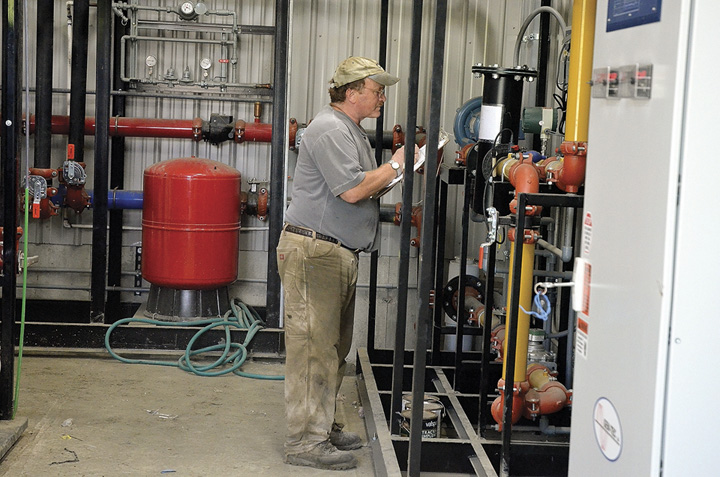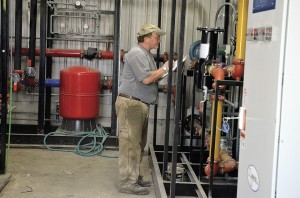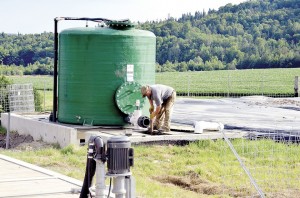

copyright the Chronicle July 25, 2012
by Joseph Gresser
GREENSBORO — On Sunday morning Peter Gebbie had finished milking. The truck from the St. Albans co-op was loading and his hands were moving out to get the second cut of hay in.
But there was more for him to do. He and his wife, Sandra, headed toward a new building behind one of his barns. A sign on the door wisely warned against entering without hearing protection. Inside an engine roared.
Mr. Gebbie grabbed a clipboard and walked around the room checking readouts at various points along a complicated series of pipes.
He looked pleased at the results. “Eighty kilowatts,” he said. When they first started the generator about two weeks ago, it produced only 20 kilowatts.
When it is running at full speed the methane generator will produce 150 kilowatts of power.
Switching the generator on was the culmination of a process that began in Newport a little more than five years ago at a meeting sponsored by the state Agency of Agriculture. That meeting at the East Side Restaurant brought together dairy farmers who were interested in the process of turning manure and other organic matter into methane and eventually electricity.
At the time the Gebbies were milking 200 cows at Maplehurst Farm. The farmers who were getting into the electricity business had herds ten times the size of his.
On Sunday, Mr. Gebbie recalled that when he first started calling firms that design and install methane digesters he was turned away.
“The guys who sold digesters laughed at you,” he said, “unless you were at least a 1,000-cow farm.”
Mr. Gebbie persisted and eventually his calls started getting returned. He said that it seemed to him that the digester builders had worked their way through the big farmers and were ready to deal with someone his size.
While they were investigating the possibility of building a methane digester, the Gebbies doubled the size of their herd to 400 cows.
They were fortunate in having long before set up their barns with slatted floors through which the cows tread their manure and bedding. Gravity was enough to move this fuel into the digester, a round tank with a flexible cover.
Manure will produce methane with or without special equipment, but left to nature the volatile hydrocarbon will go into the atmosphere where it is a potent greenhouse gas.
Mr. Gebbie said he has heard it has a 24 to 25 times greater effect than carbon dioxide.
The Gebbies knew that things were going well when they saw the cover on the digester begin to balloon upwards. That indicated that gas was beginning to build up a head of pressure.
From the digester the gas goes into a scrubber which removes impurities to protect the engine of the generator. Mr. Gebbie said he is lucky because the gas produced by his manure is low in sulfur.
From the scrubber the gas goes to the generator or, if for some reason the generator is down for a while, through an upright pipe which is set up to burn extra gas to keep it from going into the atmosphere.
Once the manure is run through the digester, it could be spread on fields. The Gebbies have chosen to separate the liquids from the solids, spread the former and use the latter as bedding.

Sawmills used to give away sawdust, Mr. Gebbie noted. Today they use everything, and the price of bedding is a major cost of doing business. By producing his own bedding, Mr. Gebbie said, he can save as much as $20,000 a year.
Studies show the bedding produced by digesters reduces the incidence of mastitis and results in a lower somatic cell count, an indicator of a healthy cow, Mr. Gebbie said.
Of course, electricity is the main product of the system. The Gebbies have a contract to supply 150 kilowatts of power to the Hardwick Electric Company through the state’s Sustainably Priced Energy Enterprise Development (SPEED) program.
They are guaranteed a price of 14 cents a kilowatt-hour, well above the current market price of four cents. In addition they can sell Renewable Energy Credits (REC) through the Cow Power program started by Central Vermont Public Service and now under the auspices of Green Mountain Power.
Mr. Gebbie said the REC credits bring in an additional three to four cents a kilowatt-hour, less a small brokerage fee.
The system cannot operate at full capacity with only the manure produced on his farm, Mr. Gebbie said. To get to the full 150 kilowatts, he will need to find an outside source of carbon.
Typically that means a liquid such as whey, he said.
The 150-kilowatt limit is convenient in one regard. Power from the system can be moved on a simple single-phase line, the sort that typically serves a home.
Large scale generators on the farms in Franklin and Addison counties may generate more than a megawatt of power and require a very expensive three-phase service to move electricity off the farm.
In addition to power and bedding, the generator can also provide heat for the Gebbies’ home and milking parlor, and hot water, Mr. Gebbie said. The potential savings could be as great as those from the bedding, but they will require substantial investment in underground pipes, he added.
The digester cost “$1.5-million and climbing,” Mr. Gebbie said. Grants from the Natural Resources Conservation Service, Department of Energy and the state Department of Public Service’s Clean Energy Development Fund helped pay between half and three-quarters of the cost, he added.
“Most people would like to see things paid in five years,” Mr. Gebbie said.
contact Joseph Gresser at [email protected]
For more free articles from the Chronicle like this one, see our Featuring page. For all the Chronicle‘s stories, pick up a print copy or subscribe, either for print or digital.







